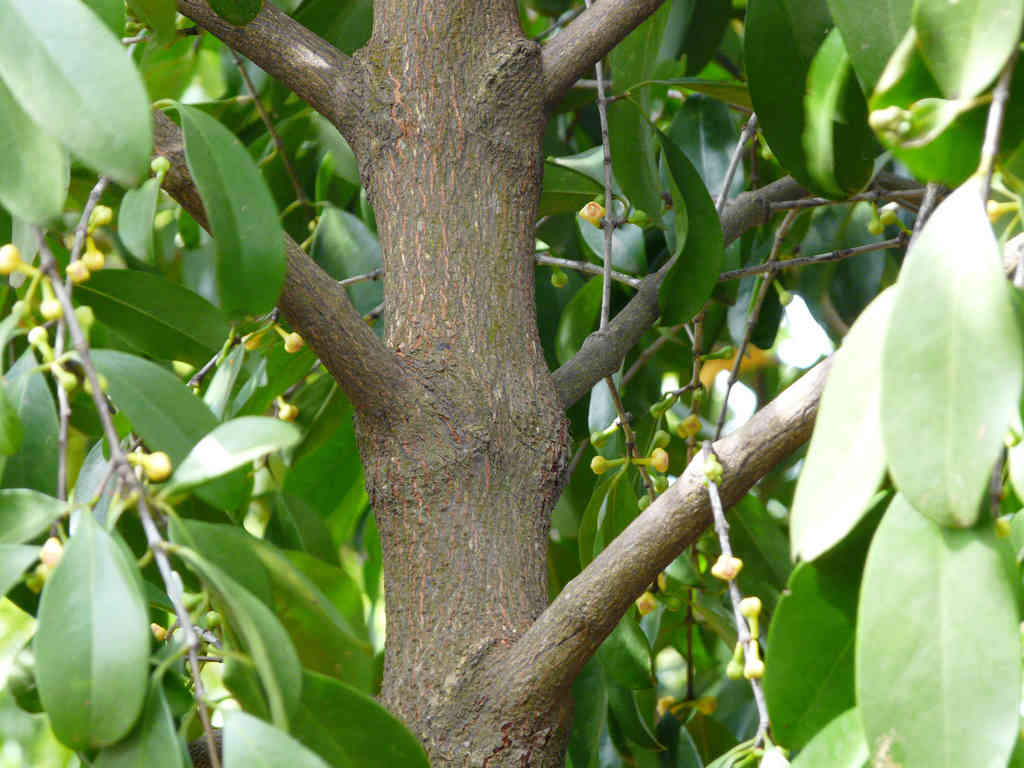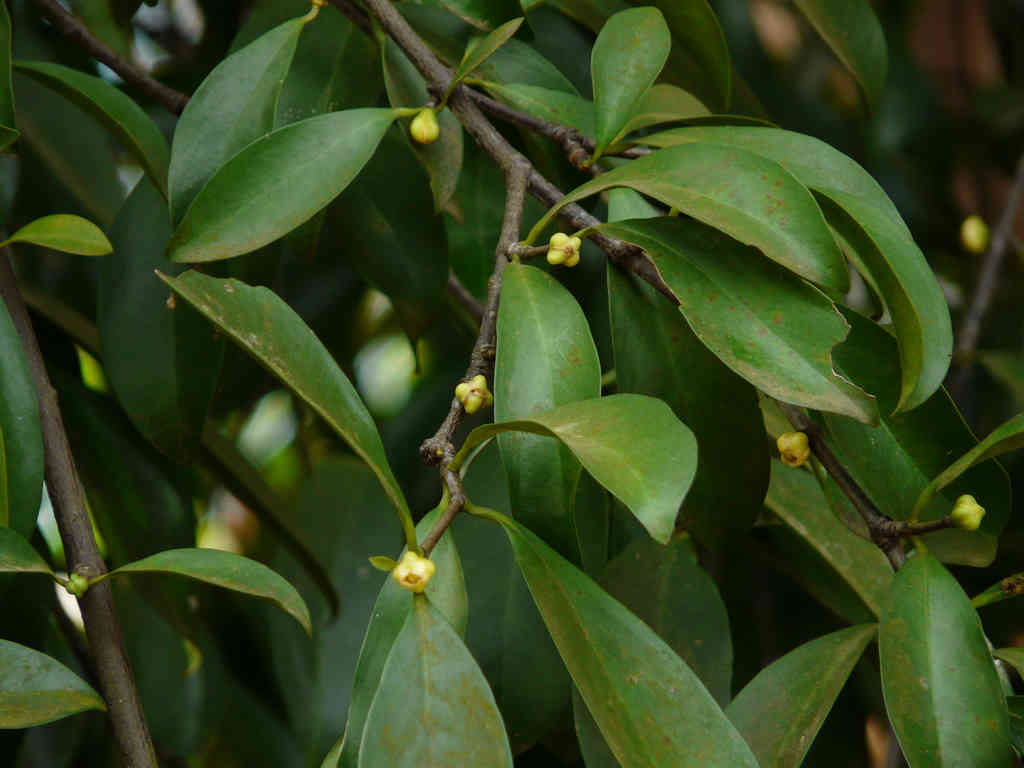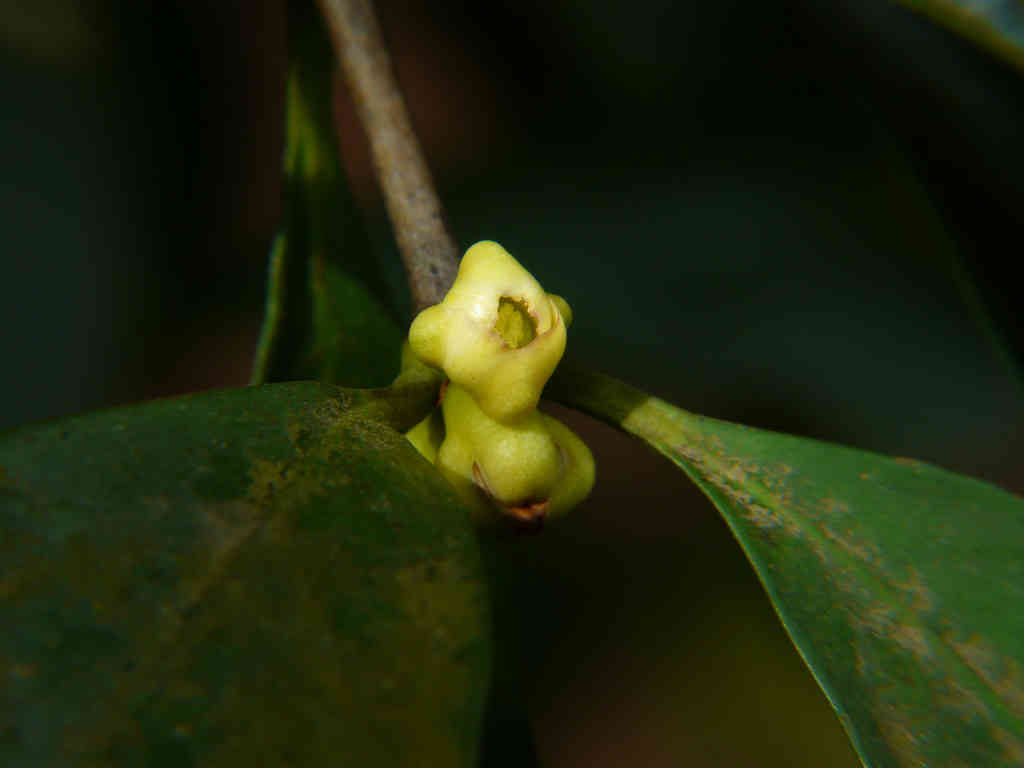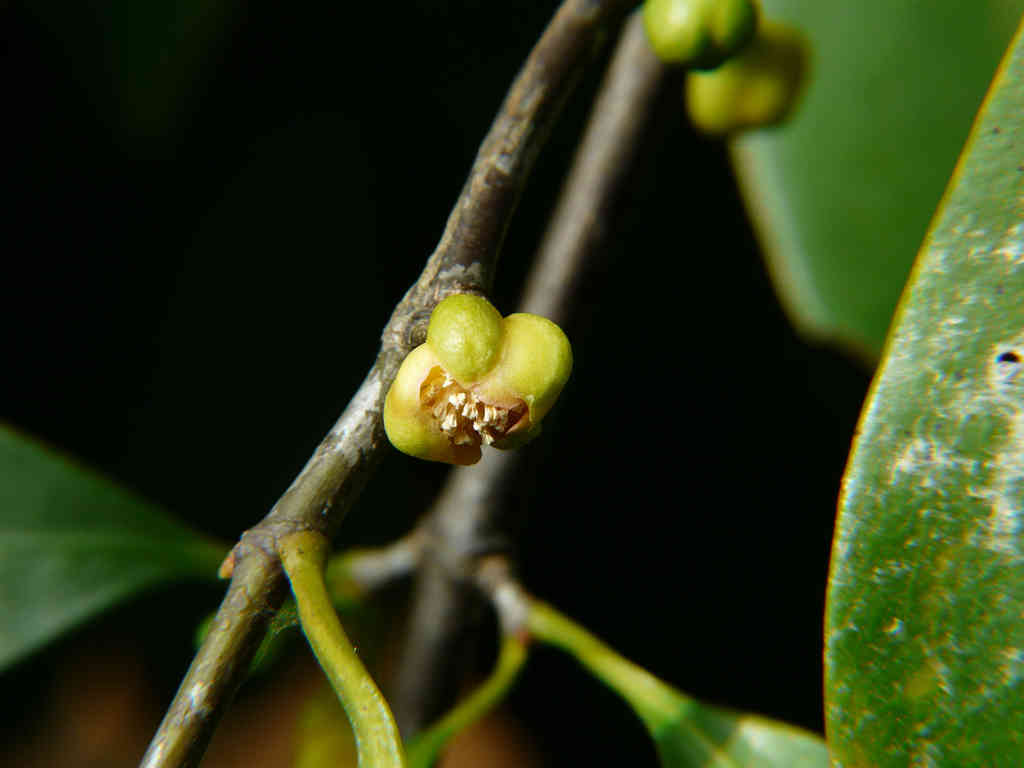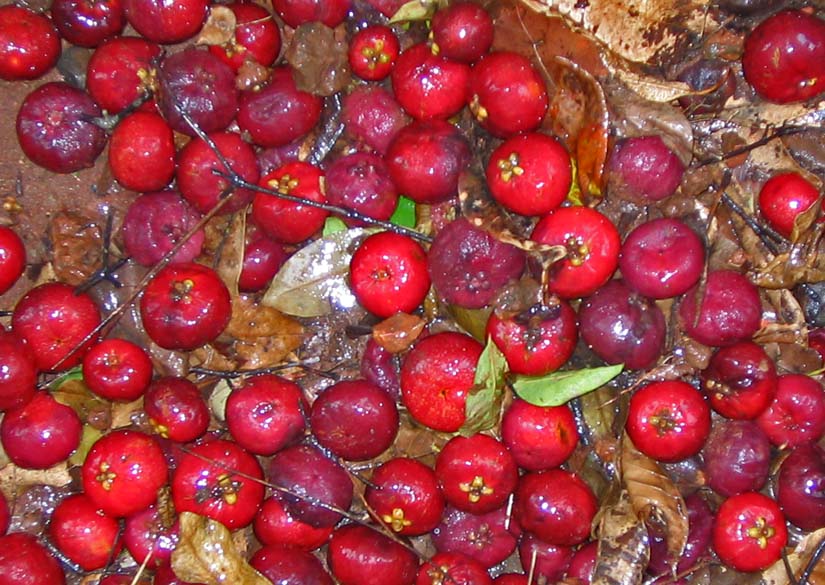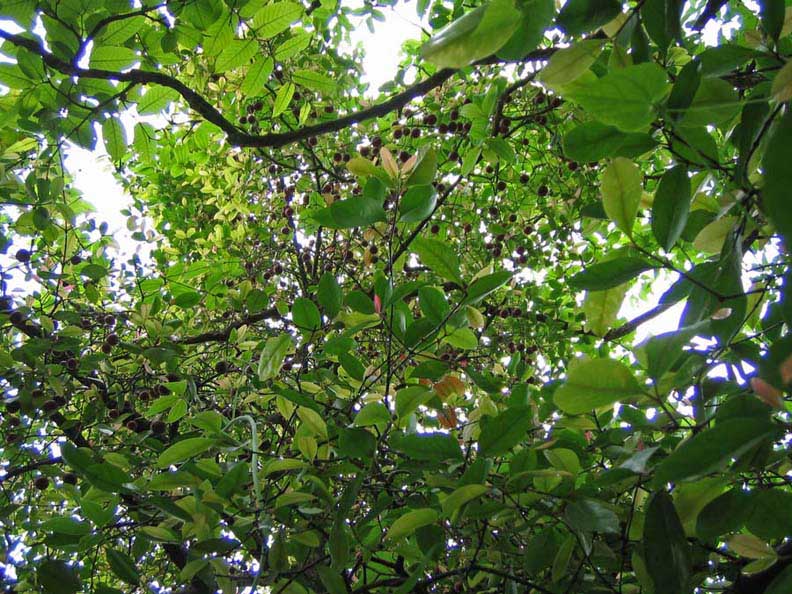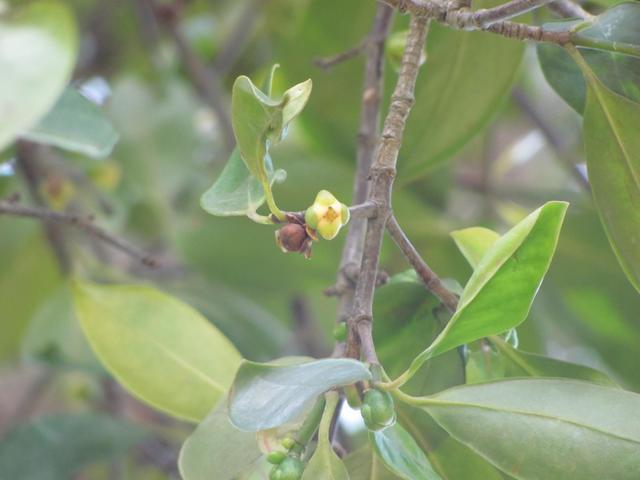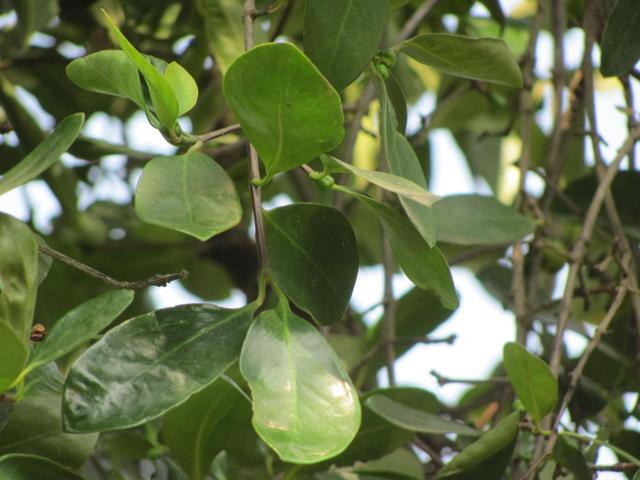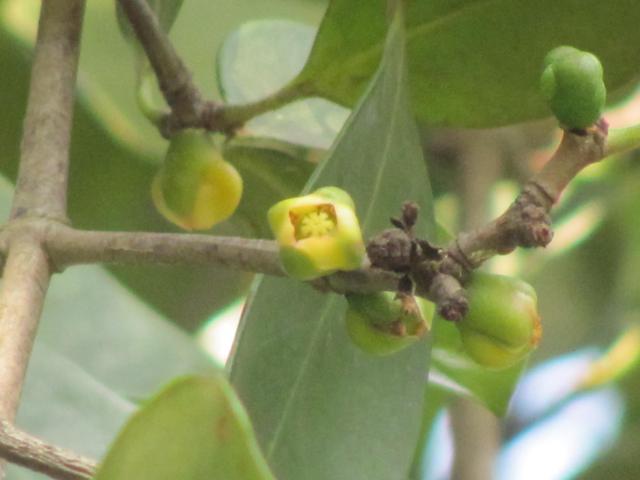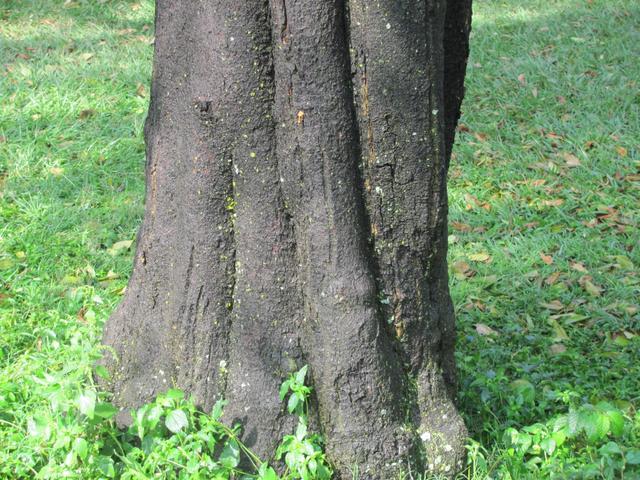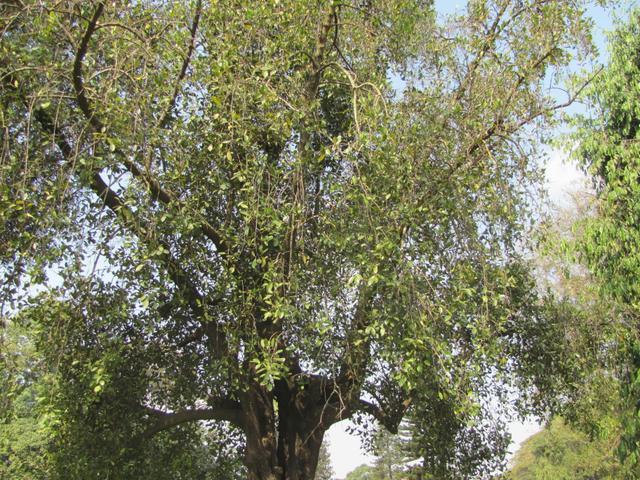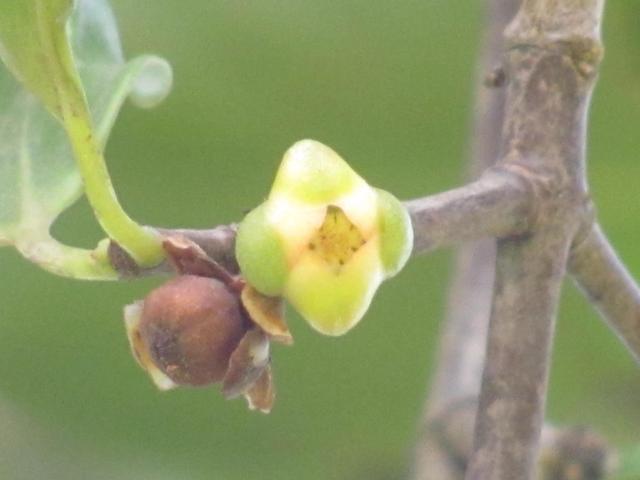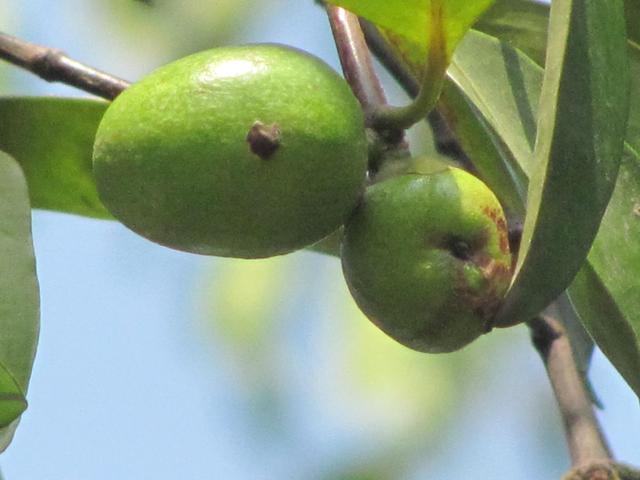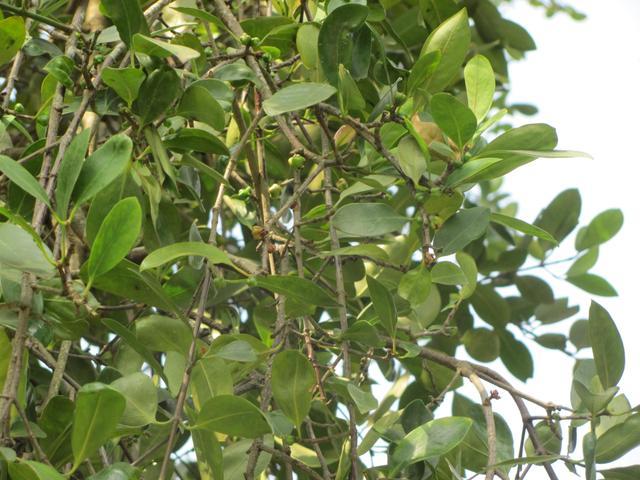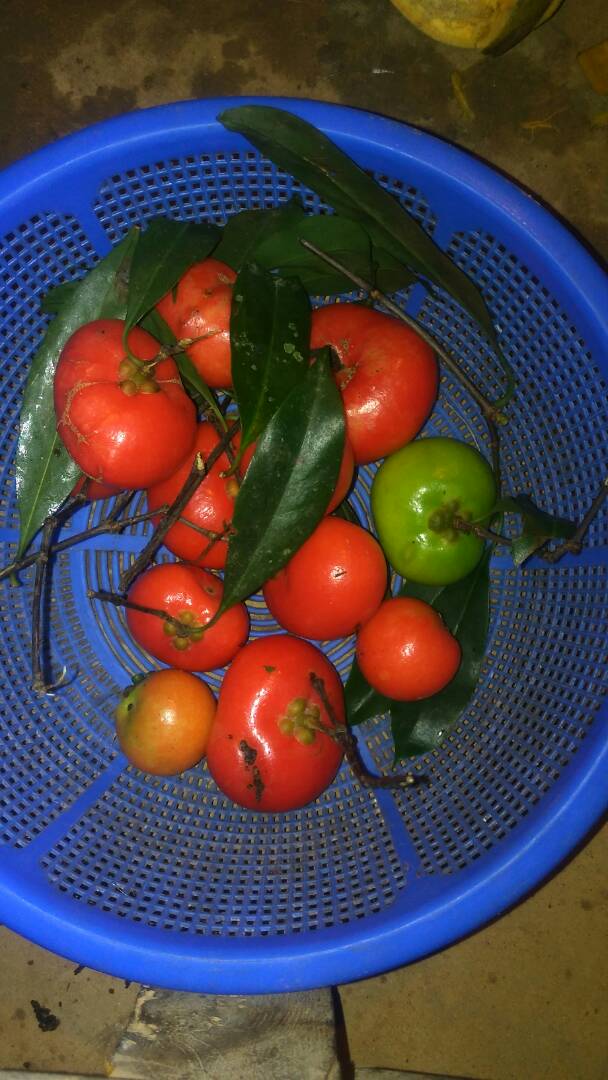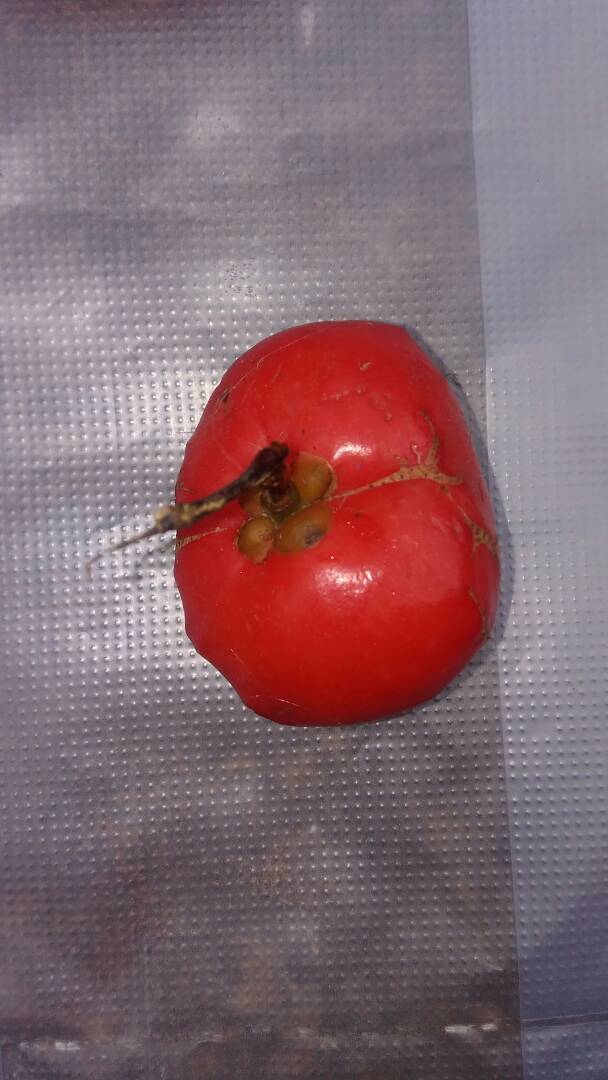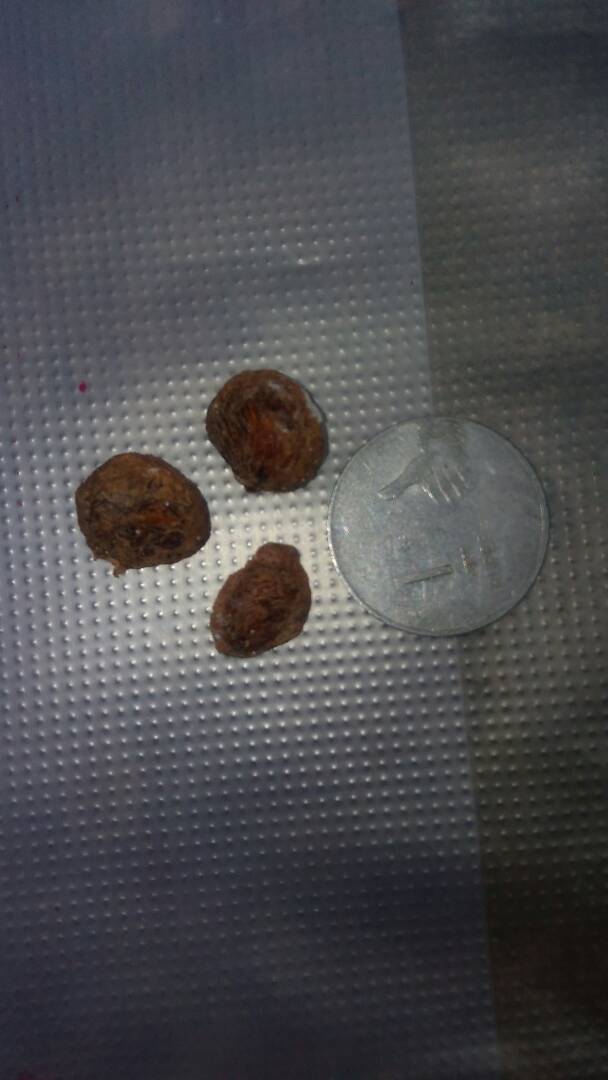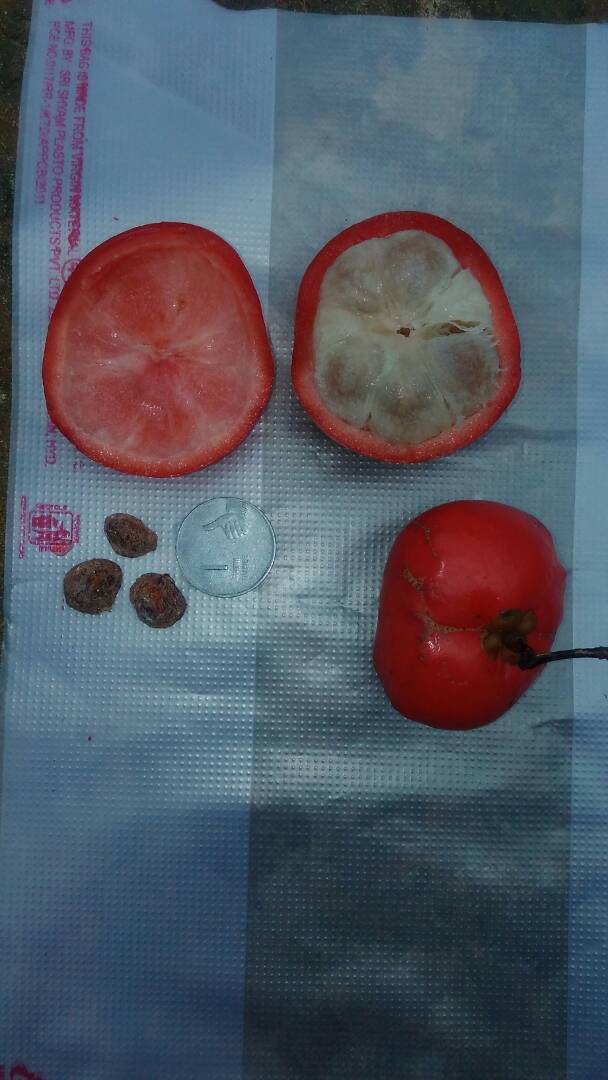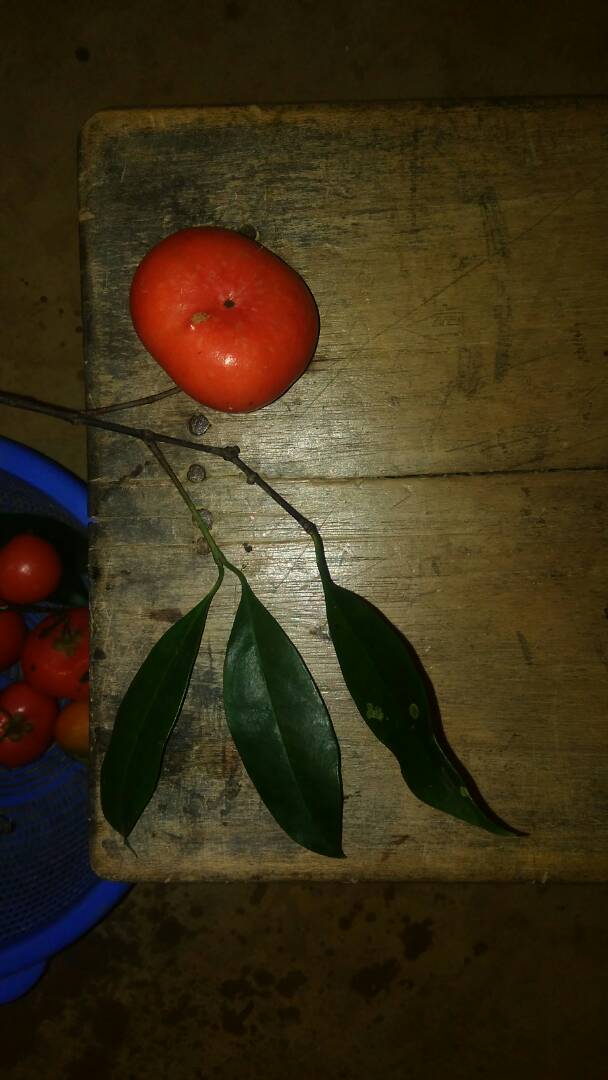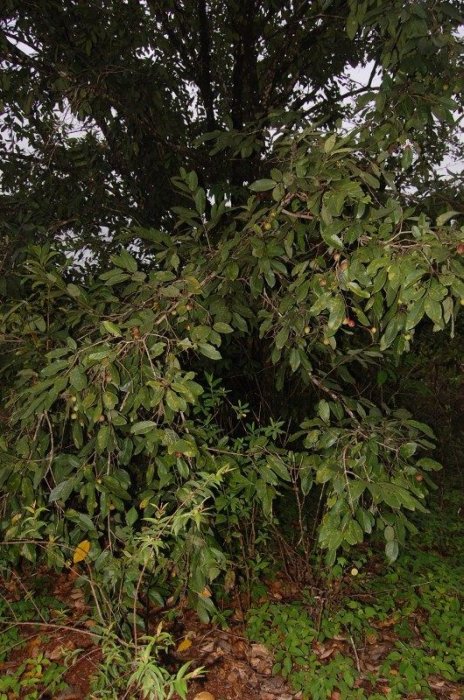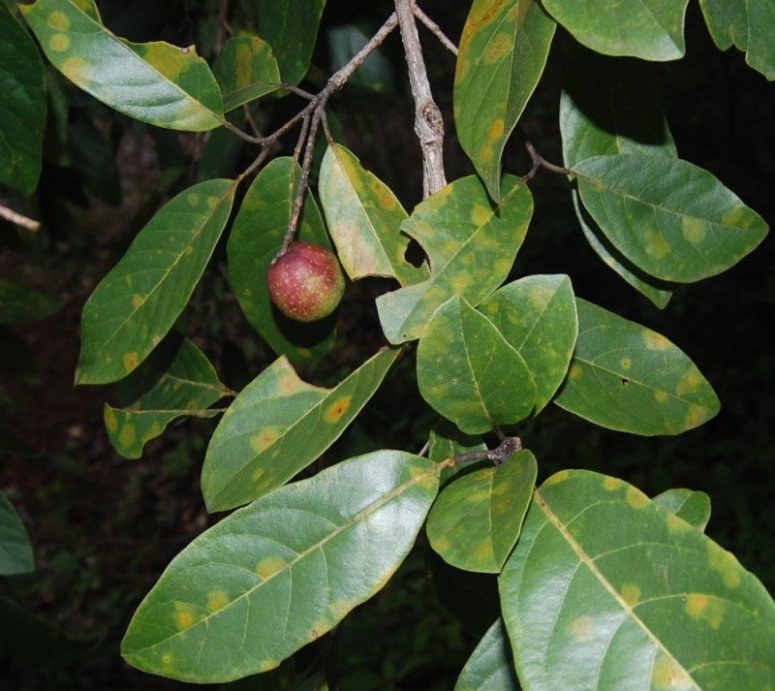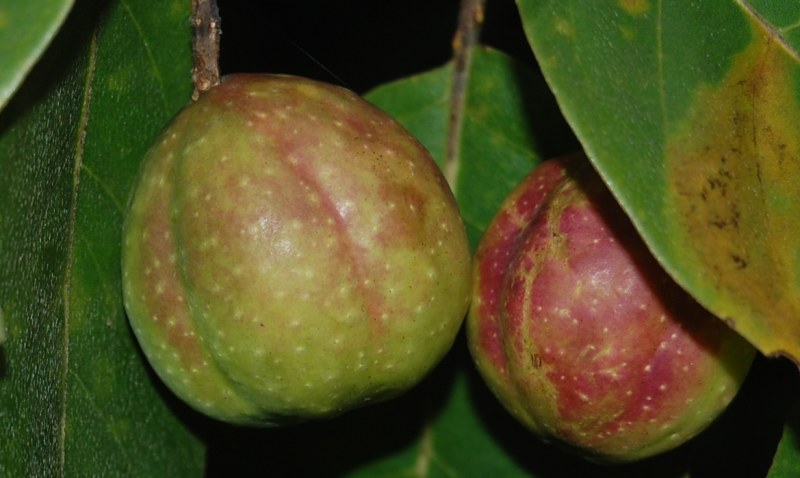|
IUCN Red List Status: Vulnerable (VU) … pulp of ripe fruit (as FRUIT) … used for making sherbat
… pulp of slightly under-ripe fruit (as VEGETABLE) … used for making sol kadi served along with meal
… dried rind of fruit (as SPICE) … preferred substitute for tamarind in kitchens of Konkan
.
Clusiaceae (garcinia family) » Garcinia indica
Synonyms: Brindonia indica, Garcinia purpurea gar-SIN-ee-uh — named for Laurent Garcen, French botanist who was active in India
IN-dih-kuh or in-DEE-kuh — of or from India Endemic to: India (Konkan and Western Ghats); elsewhere cultivated Edible use: … pulp of ripe fruit (as FRUIT) … used for making sherbat
… pulp of slightly under-ripe fruit (as VEGETABLE) … used for making sol kadi served along with meal
… dried rind of fruit (as SPICE) … preferred substitute for tamarind in kitchens of Konkan
garcinia indica: Garcinia indica or kokum growing in the wild on a road side cliff in Goa
The tree was laden with fruit, a lot of which had fallen on the ground It makes such lovely Kokam Sharbat. Very tasty and very good for health. In summer better to have this. or Limbu ( Lemon) Sharbat than to have any cold drink. The syrup can be easily made at home. Garcinia indica (Thouars) Choisy (vernacular name: Kokkam) of Clusiaceae family.
Garcinia indica: Garcinia indica photographed today ( 03.11.11) at herbal garden of BVP University , Pune.
It has flowering season of November-Feb. But it has no flowering till now. nice and one of my favourite plant, plant fruits in month of april to may, so i guess it should flower during feb to march.. anyways thanks to plant it keeping you busy.. Nice to see this Kokum tree. Garcinias can be recognized (in the absence of flower/fruit) in the field by their horizontal branches, yellow sap (when you slightly cut the bark), and leathery leaves. Trees of Lalbagh, Bangalore – Garcinia indica – kokam Tree: Kokum is a tree with a dense canopy of green leaves and red-tinged tender emerging leaves. It is indigenous to the Western Ghats region of India, along the western coast.
The tree is large and handsome, having elliptic, oblong or oblong-lanceolate, deep-green glossy leaves, 5.5-8 cm long and 2.5-3 cm broad. The flowers are fleshy, dark pink, solitary or in spreading cluster.
The fruit is brownish or brownish-gray, marbled with yellow, and is crowned by the 4-parted, stalkless stigma. There are from 6 to 8 seeds, and the pulp is juicy, white, and delicious in taste and odor. It is about the size of an orange. An average kokum tree bears hundreds of fruits during summer. When they are tender, they are green in color. As they ripen, they get the beautiful purple color. The fruits are plucked when they are ripe.
The tree is a source of kokam butter which is used in cosmetics and confectionary.
Flowering: November-February An important ayurvedic fruit and tree… Konkan, May 2014 :: Garcinia indica :: 12JUN2014 :: ARK-24 : 1 post by 1 author. Attachments (8). Seen the flowers of this tree in the last week of December 2020 (near Devgad, Konkan coast, MH).
2 images. Garcinia indica (Thouars) Choisy, from IIHR Bangalore,
Kokam butter used in medicne, i though c. cambogia and c. indica were the same?
are they not? No, both are different. G gummigutta (=G.cambogia) is a bigger tree fruits with ridges and furrows, G. indica fruits used for making soft drink, seed fat is kokum butter. oh thanks’
than wikipedia is wrong!!! is it possible to buy these fresh in markets? Hypericaceae, Clusiaceae and Dipterocarpaceae Fortnight:SN 11 : 1 post by 1 author. Attachments (2)
Garcinia indica (Thouars) Choisy
fruiting twig and cut open fruits from the forest department garden, Sirsi, Karnataka. Hypericaceae, Clusiaceae, Dipterocarpaceae Fortnight :: Clusiaceae :: Garcinia indica :: Devgad, Maharashtra :: ARKNOV-03 : 3 posts by 2 authors. Attachments (7).
Attached are pictures of Garcinia indica captured at Devgad, Maharashtra in May 2014.
Had posted this pics earlier on the forum as well.
Fairly common in these areas, fruiting around April-May (along with mangoes :)) when the fruits are harvested and dried in the sun to get ‘kokum’. Nice set of pics of Kokum..
TSP-MAY2016-20-349:Images of Garcinia indica (Clusiaceae) : 7 posts by 3 authors. Attachments (6) It is my pleasure to share few images of Garcinia indica (Clusiaceae) Ref: http://www.flowersofindia.net/catalog/slides/Kokam.html Ref: http://florakarnataka.ces.iisc.ernet.in/hjcb2/herbsheet.php?id=1091&cat=1 Habit: Tree Habitat: Evergreen forest Sighting: Chikmagalur, Karnataka, about 1200 msl Date: 12-08-2015, 28-11-2015, 25-03-2016 and 01-05-2016 What is the approximate diameter of the berries? I did not measure them, but have a fair idea. It is between 2.5 – 3 cms. I brought home a few of them for my kids to taste. Garcinia Species in Tripura- 1 : 4 posts by 1 author. Please identify this Pl. check with images at Garcinia indica (Thouars) Choisy as per comparative images at Garcinia
Location Rajnagar Kumarghat Unakoti district Tripura I sent two photos with leaves to you (The fruits have no ridges) along with other photos of Garcinia (The fruits with ridges). Please check Garcinia lanceifolia. Illustrations of Garcinia lanceifolia available at
Yes Professor, it is Garcinia indica Small Tree for ID : Lalbagh Botanical Garden, Bangalore : 27JAN20 : AK-35 : 4 posts by 2 authors. Attachments (5) Is it Garcinia indica? May be as per images at Garcinia indica from Lalbagh A fruiting tree found on top of the Gamayana gudda (Hill), Uttara Kannada.
Deer climb up the hill in search of this fruit.
Local Name (Kannada): Hanale Kai, Gamayana gudda, Western ghats, 25 June 2009
PS: I could not get the scientific name from the internet. Its a well-known fruit among locals. … absolutely wild guess … some Diospyros species ? Just a guess. may be a Garcinia fruit I think it is Garcinia cambogia? Is ‘garcinia cambogia’ any different from the kokum fruit one sees in the konkan region Yes, it is different. See the following link: Parayilat
There seems to be something wrong in the blog cited by you. I wonder if … has tasted Mangosteen? I wonder how anybody who has tasted both kudampuli and Magosteen can make a remark that one is the other name of the other. Please don’t react like that. Please read the blog carefully. … does not write Kudampuli and Mangosteen are same, he writes ‘It looks (Kudampulli) like inside of mangosteen fruit’. He also also correctly writes Kokum and Kudampulli are different. My appologies if I have offended anybody. It is not my intention to hurt anybody. My language was rather strong, I apologise for it. I was refering to the sentence I am copying here “The scientific name for kokum is Gracinia indica. Some of the other names are amsul, katambi, panarpuli and mangosteen. Photo on the left shows two kokum fruits”. Yes …, it is a mistake as you rightly pointed out. Let us enjoy the interactions on this group, and not get upset by mistakes by others. I being botanist, know there are so many wrong identifications on different websites, which confuse others. We have to tolerate them. This will be G. indica as per Diversity of Garcinia species in the Western Ghats (pdf): JNTBGRI- Diversity of Garcinia species in the Western Ghats: Phytochemical Perspective- P. S. Shameer, K. B. Rameshkumar and N. Mohanan. Pl. see Garcinia indica
. Tree for ID : Mumbai : 03APR21 : AK-01: 3 images. Bark was dark in color.
Garcinia Species?
Pl. post high resolution images. Adding one by one. Can it be Garcinia talbotii, though it is very difficult to say in vegetative stage? I cannot say with these images, sorry. Adding more pictures.
The leaves are thin, glossy.
The tree is growing straight almost as tall as the Coconut tree next to it.
Tender leaves are pink.
8 images. yes Garcinia species for sure. Thanks for supporting my suggested id of Garcinia.
The dark bark reminded me of Garcinia indica.
After you suggested Garcinia, I tried the fallen leaf which I had picked up earlier.
It is sour to taste.
So there is a possibility this could be Kokum, Garcinia indica.
Also, images on Eflora from a herbal garden in Pune are very close to this tree.
Yes, Garcinia indica is quite likely. This tree can grow very tall in crowded spaces. The colour of new leaves matches as well as the texture. G. talbotii on the other hand has thicker leaves. Sour taste is also an indication for G. indica. You are correct.
There are many trees together.
Will look out for the flowers or fruits.
Garcinia indica came to my mind initially, because of the dark bark.
. References:
|
Garcinia indica
Updated on December 24, 2024

